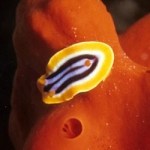Sponges
Nudibranchs -- marine snails without shells -- make wonderful photo subjects for the macro photographer. They are small, colorful, and they move slowly (as snails are wont to do). That last characteristic is particularly welcome. Most fishes are in motion almost constantly, and non-sessile invertebrates tend to scurry hither and thither. It's nice to find a subject that is not only photogenic, but doesn't turn tail or flat out disappear before the photographer can focus the camera's lens!
It's always interesting to find out and record which critters feed on what. Here are some macro…
Sponges are among the most primitive of all animals. They are immobile, and live by filtering detritus from the water. They have no brains or, for that matter, any neurons, organs or even tissues. If you were looking for the evolutionary origins of animal intelligence, you couldn't really pick a less likely subject to study.
So it was with great surprise that Onur Sakarya from the University of California, Santa Barbara found that sponges carry the beginnings of a nervous system.
With no neurons to speak of, these animals still have the genetic components of synapses, one of the most…
In Shark Bay, off the Western coast of Australia, a unique population of bottlenose dolphins have a unusual trick up their flippers. Some of the females have learned to use sponges in their search for food, holding them on the ends of their snouts as they rummage through the ocean floor.
To Janet Mann at Georgetown University, the sponging dolphins provided an excellent opportunity to study how wild animals use tools. Sponging is a very special case of tool use - it is unique to Shark Bay's dolphins and even there, only about one in nine individuals do it. The vast majority of them are…
